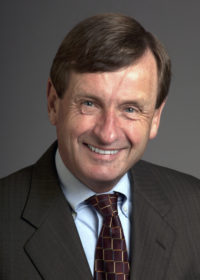
On June 5, 1981, five cases of Pneumocystis carinii pneumonia, an often fatal and rare infection, were reported to the CDC. Very rapidly, the CDC’s epidemiologic investigations indicated a pattern of fatal infections and cancers caused by a breakdown of the immune system that was termed acquired immune deficiency syndrome, or AIDS.
Thirty years ago this summer, I led a CDC task force to study those first cases of AIDS. We have made great strides and learned much about the global epidemic since the early days, but there are three things that I think should be emphasized as we look back. One is that AIDS should still be considered a new disease. Second, it is complicated. And third, people really are the most important thing.
When I say it is a new disease, I’m not referring to when the first infection was transmitted from a chimpanzee to a human, which we now think was many decades ago in Central Africa. I’m referring to another question: When did it begin to occur with any frequency or with any importance anywhere? In those early days in 1981, it was an uncommon occurrence to have anybody sick with AIDS. The United States was one of the first developed countries to experience the disease. Even in Africa, where HIV, the virus that causes AIDS, possibly originated, most countries still had no infections in the early 1980s. And now we have something that is the fourth-leading cause of death in the world – with more than 1 million cases and more than half a million deaths in the United States alone. It really is brand new.
And it is very complicated. We spend a lot of time as scientists thinking about the virologic complexity – how complicated the virus is and the intricacy of the treatment. But the real complexity is the social and cultural complexity of the disease, which makes it difficult to understand why everybody isn’t tested, why everybody isn’t treated, why everybody doesn’t have access to health care, and why there remains so much discrimination against homosexuality and drug use and sexual transmission. Some of it is easy to understand, but in every society and in every community, it’s difficult to talk about sex. It’s not too difficult to talk about it in many churches, but they simply don’t do it. It is a very complicated problem, and it has to be dealt with in a complex way.
The final point is that people make the difference. HIV-infected people themselves – some of whom are health care providers, some of whom are scientists, many of whom are advocates and many of whom died in the first 15 years of the epidemic before the discovery of today’s lifesaving antiretroviral drug therapies – all have made a huge difference. They have become role models on how to openly live their lives with a fatal infection that scares many people. That includes people like Larry Kramer, Magic Johnson and Ryan White. It includes such supporters of people who are HIV-infected as Elton John, Michael Jackson, Elizabeth Taylor and others who gave something of themselves to stand up for a controversial cause. The scientists and clinicians who have worked on AIDS have also been important advocates for their patients and for the community. They have become advocates for the world.
AIDS: Here to Stay
HIV/AIDS remains and will remain a very important and difficult public health problem, locally and globally. There is no simple solution. Even the discovery of a vaccine or a cure would not mean an easy solution. Think about it. If a cure were developed, we would still have to find the 30 million infected people in the world and cure them before they infected others. Or, if we develop a safe vaccine that is 100 percent effective in protecting against the virus, we must administer it to billions of people across the planet.
We must learn from the lessons of the last 30 years ago about this deadly epidemic. We need continued strong science and education, and prevention efforts must be renewed. I can’t think of anything better than being part of the army working to find a cure or a vaccine, but we’re going to need commitment for the rest of our lives to fight this global disease.
Be informed. Get tested. Be safe.
James W. Curran, MD, MPH, dean of Emory’s Rollins School of Public Health, led a task force at the CDC to investigate the first reported cases in 1981. He subsequently directed the Division of HIV/AIDS and was appointed assistant surgeon general of the United States. After Curran was appointed dean in 1995, he led the formation of the Emory Center for AIDS Research. He recently received the 2011 Ryan White Distinguished Leadership Award for his lifetime of significant contributions to AIDS prevention and continues to serve as a national and international adviser on AIDS. For more information about Emory’s efforts to fight AIDS: http://bit.ly/aids30emory.
